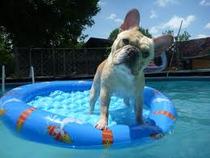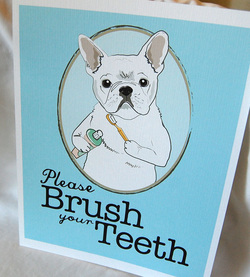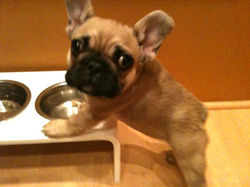|
How to Prevent Parvovirus
Parvovirus is an extremely contagious virus to dogs and attacks the intestine causing vomiting, diarrhea and even death. The cardiac form of parvovirus effects young dogs 8 months old and younger, and can often cause sudden death. Fortunately, parvovirus can be prevented with proper precautions. Instructions o Vaccinate your dog regularly to prevent parvovirus. Vets recommend beginning when the puppy is 6 weeks old, applying vaccinations every 3 to 4 weeks until the dog is 16 to 20 weeks old. After initial vaccination of puppies, parvovirus can be prevented with one yearly vaccination. o Protect your puppy or unvaccinated dog from parvovirus by keeping him away from areas where there are strange dogs or even dog poop such as the park, pet stores and even your own front yard. Because parvo is extremely contagious and the virus is very resilient, a simple sniff of an infected dogs waste can spread the disease. o Allow your puppy or unvaccinated dog to interact with other dogs only if you are absolutely sure that their vaccines are current. Because it takes time for the virus to cause symptoms, an infected dog may show no signs of infection. o Prevent parvovirus by keeping your puppy or unvaccinated dog away from puppies, even if they have received part of their vaccination series, as the disease can continue to incubate with no signs or symptoms until the series is complete. When you take your puppy to the vet, DO NOT set your puppy on the ground or other surfaces that a sick puppy may have been on. Request that vet staff wash their hands. DO NOT let other pet owners touch your puppy (their pet may be sick) Tips & Warnings It is extremely important to realize that dogs will remain susceptible to parvo for as long as 4 weeks after the final injection of the vaccination series, so take preventative measure with young puppies until they are 20 to 24 weeks old and have received all of the injections
0 Comments
 SUNNY DAYS!!! BEWARE HEAT STROKE! Winter is coming to an end & its time for dog parks, frisbee, and dogge playdates! Enjoy! As responsible owners, be aware that heat stroke is a major concern for Frenchies! Your frogdog will play and romp with such energy, and easily overdo in warmer weather. Know what the signs are and how to treat heat stroke. Below are exerpts from Linda Kalmar DVM 's article about heatstroke..... HEATSTROKE
Linda Kalmar, DVM Heatstroke occurs when the body’s normal compensatory mechanisms are overcome. Dogs are inefficient at cooling because they don’t sweat — they can only cool themselves by panting. Certain conditions such as brachycephalic faces and laryngeal paralysis can predispose dogs to heatstroke........ How can heatstroke happen to dogs that belong to smart owners like us? • Dogs left in car • Crated dog left near heat vent • Local weather changes • Travel related weather changes • Unexpected shutoff of A/C at home or in motor home • Dark coated dogs in the sun absorb more heat than light coated dogs Early signs of heat exhaustion: • Heavy panting •Weakness • Confusion / lack of attention • Possibly vomiting /diarrhea • Bright red gums/tongue (and red ears in Frenchies with pink ear linings). The gum should show rapid capillary refill; that is when you draw your fingernail along it the gum should whiten, but then quickly turn red again. • Increased salivation early (often thick, ropey saliva), then no salivation Severe heat stroke signs: • Rapid heartbeat / pulse • Vomiting blood • Bloody diarrhea • Severe ataxia (staggering) • Coma • Gums may turn greyish, blueish, lavender.diarrhea “ “ So I see a dog in distress; what should I do? • Move dog to shade/cooler place immediately • Mist dog heavily with tepid water to cool (BUT NOT COLD) water and turn a fan on it. If no electric fan is available, fan it yourself. The aim is to move air over the dog’s body so at to cause the water to evaporate and “pull” heat with it (evaporative cooling). • DO NOT PLUNGE DOG INTO ICE OR ICE WATER!! The capillaries at the surface of the skin,.....will constrict in response to the cold, thus slowing heat loss and possibly even raising the dog’s core temperature. Even tepid water is much cooler than the dog’s body temp. The most important need is to get the air circulating. * Do NOT lay wet towels on the dog. These warm up rapidly and can actually trap the heat. Air movement past the dog’s damp skin is the key! • Don’t use large amounts of alcohol for cooling as it can be absorbed through the skin and reach toxic levels. Continue to monitor the dog’s rectal temperature and stop cooling efforts when it gets down to 103 F. At that point you can dry the dog off and move the fans back a bit, as you don’t want its temp to drop too far too fast. If the dog is alert it is ok to offer a little cool (NOT ICY) water. Continue taking the rectal temp for awhile to make sure the temp continues to fall. Should it start to rise again, re-mist and fan some more. If the dog was in actual heatstroke — not just the early stages of heat exhaustion — it is vital to get him/her to a veterinary clinic where he/she can be monitored around the clock for two or three days. That’s because when the body temp goes above 106 F, the cells actually “cook” ..........changes occur which can lead to liver and/or kidney failure, ...swelling of the brain......This can then lead to internal hemorrhaging and death.......... If you are able to get a dog in heatstroke to the vet quickly enough, treatment will mostly be supportive: close monitoring, IV fluids, measurement of fluid intake/output, temperature monitoring, steroids.... Dogs who have suffered from severe heatstroke are at increased risk of episodes for the rest of their lives due to damage to the thermoregulatory center in the brain. So remember: PREVENTION IS BETTER THAN TREATMENT!! ******To read the entire article go to http://frenchbulldogclub.org/wp-content/uploads/2012/05/HEATSTROKE.pdf  Frenchie Dental Care HOW TO BRUSH YOUR FRENCHIE"S TEEEEETH..... 1.Wrap gauze or a washcloth around your finger and use it like a toothbrush on the pet’s teeth. This is a gentle way to introduce your pet to brushing. Wipe all the teeth, front and back, with strokes from the gum line to the tip of the tooth. Do this for one to two weeks until your pet is familiar with having its gums and teeth rubbed. 2.Gradually progress to a soft toothbrush and plain water. After a week of using a soft toothbrush, add a small amount of special dog toothpaste. Never use human toothpaste as it may irritate the pet’s stomach. 3.In oval motion brush the front and then the upper and lower teeth in the back at a 45-degree angle to the tooth surface. Scrub in the crevice where the gums meet the teeth, this is where odor and infection begin. 4.Feeding your French Bulldog dry dog food and then offering hard biscuits after each meal can drastically cut down on plaque build-up. The abrasion helps keep plaque to a minimum on the crown of each tooth. Be as proactive in your Frenchie’s health as you are in the lives of your other children. Because after all, they are a vital component of the family unit deserving of love, attention, and time .Untreated teeth can cause serious problems in pet’s health. Like in humans, it can affect other parts of the body. In your pet, they can cause heart and kidney disease. Regular veterinary dental checkups can help prevent serious problems and keep your pet healthy. Pet teeth cleaning includes use of a short-lasting anesthetic that allows for gum line probes, removal of tartar and tooth polishing. A good way to remember to schedule a dental exam is to combine it with your pet’s annual booster vaccinations. Just as important to annual dental exams is dental care at home, such as brushing your pet’s teeth at least three times per week. AAHA suggests this technique for both younger and older animals, although it’s easier to start brushing when the pet is young. Frequent face cleaning is a must!
To keep the wrinkles clean and infection free, daily to weekly face cleaning is recommended. This doesnt have to be a chore.... 1) Baby wipes- use daily to wipe nose wrinkles and inside ears. just a quick wipe down, less than a minute, can keep a fresh Frenchie face! 2)Johnson's baby shampoo- the No More Tears formula can help if you are worried about getting soap in your Frenchie's eyes. With baby shampoo, you can scrub away at that scrunchy face and the eyes are safe! After a strange year, 2013 is a welcomed new start! Mimi and Buffy are recovering nicely from whelping pups, only one Frenchie pup still in the house (getting spoiled rotten). The morkies again were very popular and all 3 of Kitty's pups were quickly placed, even little Zoe who was touch and go for the first 4 weeks of her life and then blossomed into a beautiful little character!
Every match made, pup with person, seems to be a perfect fit, looking forward to getting updates as they grow! Libby had Christmas Day pups (only 3 survived, 1 little girl was to frail to make it but we tried). These little morkie babies will be ready just in time for VAlentines Day. New additions- June Bug and Lucy, French Bulldogs, are in their terrible teens, June teases the other dogs by taking all the toys, and Lucy is testing her standing by chewing on the big dogs feet as they pass by her.... Roxxie, my boxer, is retired now, her new profession is couch potato and she does it well! My daughter, Andria, has kept a pup from her last litter. Cali is a spoilt brindle girl, will be bigger than her momma! More news later! Gotta get back to work:) Okay! Soo excited, two litters of Morkies expected for Christmas, hopefully a litter of French Pugs, and also a litter of AKC Boxer puppies! Going to be a busy holiday season!
We have attempted a breeding of French Pugs, will know definitely if the Pug Momma is pregnant in another week or two. Roxxie (AKC Boxer) will be having a play date with Champ next week, so her pups most likely won't be ready for new homes until the last week of December.... The past litters of Morkies were so popular, and their new parents have sent us plenty of pics to keep us updated...Morkies are truly turning out to be an awesome breed! We have two litters expected, and both litters will be ready for new homes by Christmas! Well, spring is over and all my pups have been placed in happy homes! We had Pinky's chi pups (4 in all), and Roxxie's boxer pups (8 in all). The variety of colors and personalities was so amazing!
I will miss my little babies, but whew, I can rest for a while! My doggie moms did good, and will be treated to a specialty diet and exercise program to get their girlish figures back, lol! Isabell, my pug, has been bred twice but failed to have a pregnancy both times:(, so I will not be attempting again with her. She has taken on mascot and cheering section of the house! So, while everyone here at Bone2Pick Pups takes a rest, enjoy your summer! Check back with us in the fall for new arrivals! wOO! bOXER BABIES FINALLY HERE! Been on Puppy watch since Sunday night because Roxxie started nesting then, although she didn't start true labor til Wednesday night at 8:00 pm. The 1st pup was born at about 1:30 am and the last pup was born Thursday morning at 8:00am.
Haven't had much sleep this week at all, but it was worth it! Roxxie has 8 beautiful babies! 5 females, 3 boys, gorgeous and many different colors! Took them to the vet today to have their dewclaws removed and tails docked, the vet was impressed with the whole litter and how well Roxxie looks, thanks to all the dietary supplements! Check out the pictures! So excited about the month of March! I will have Boxer babies, pug babies, and Chi-chi babies! I am a nurse and I am looking forward to delivering pups, so much so that I have scheduled my vacation for the expected whelping dates! My coworkers think I'm nuts!
|
AuthorMy name is Caroline and I love my babies! Archives
December 2014
Categories
All
|

 RSS Feed
RSS Feed
